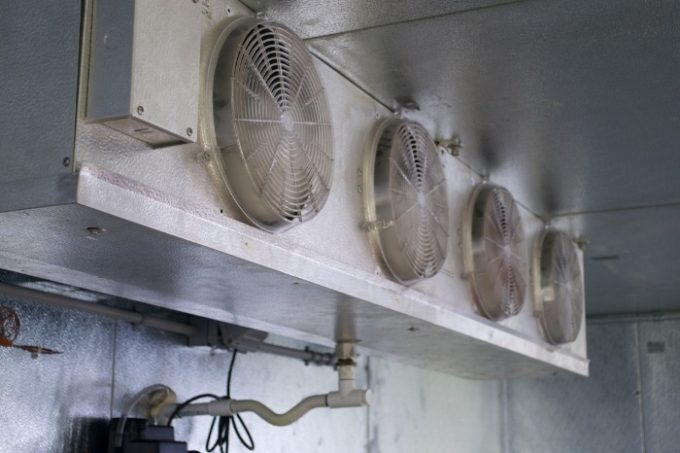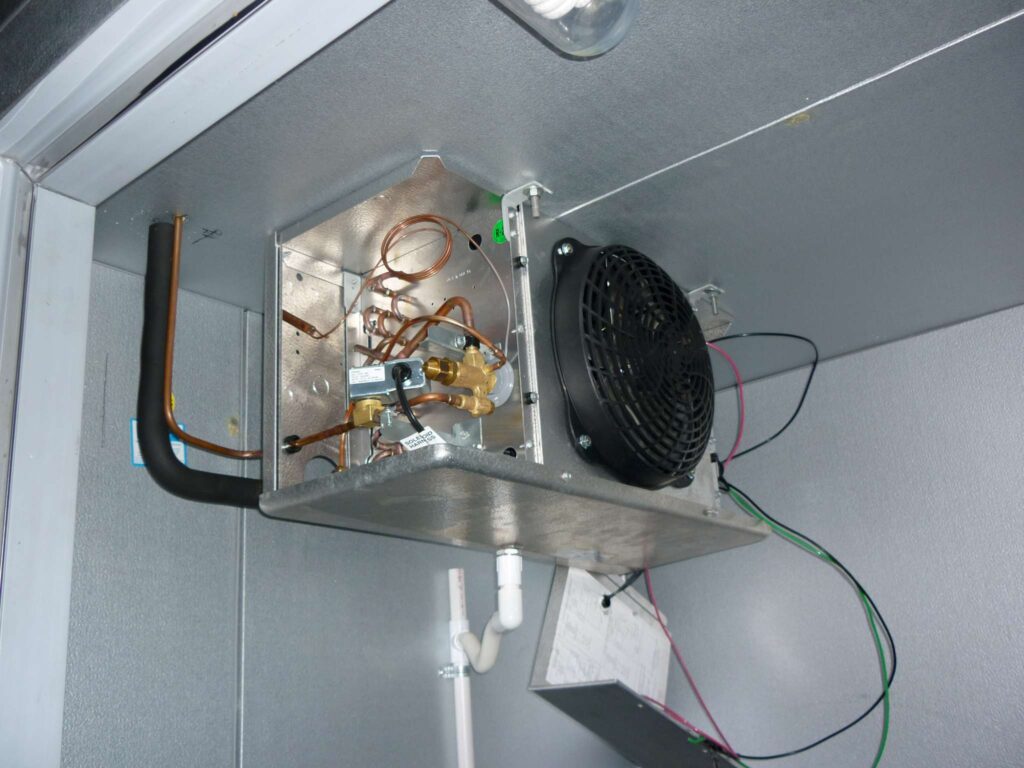01 Oct, 2020
Commercial Walk-In Refrigeration Maintenance
You may not think about your walk-in coolers and freezers often, but they are critical to your business success. Emergency repairs can be costly, not to mention the potential loss of perishables.
Often malfunctions could have been minimized or prevented with proper maintenance. Proactive walk-in cooler and freezer maintenance schedules ensure prolonged operation of refrigeration equipment.
Unit Coolers
At every six month interval, or sooner if local conditions cause clogging or fouling of air passages through the finned surface, the following items should be checked.
1) Visually inspect unit
• Look for signs of corrosion on fins, cabinet, copper tubing and solder joints.
• Look for excessive or unusual vibration for fan blades or sheet metal panels when in operation. Identify fan cell(s) causing vibration and check motor and blade carefully.
• Look for oil stains on headers, return bends, and coil fins. Check any suspect areas with an electronic leak detector.
• Check drain pan to insure that drain is clear of debris, obstructions or ice buildup and is free draining.
2) Clean evaporator coil and blades
• Periodic cleaning can be accomplished by using a brush, pressurized water or a commercially available evaporator coil cleaner or mild detergent. Never use an acid based cleaner. Follow label directions for appropriate use. Be sure the product you use is approved for use in your particular application.
• Flush and rinse coil until no residue remains.
• Pay close attention to drain pan, drain line and trap.

3) Check the operation of all fans and ensure airflow is unobstructed
• Check that each fan rotates freely and quietly. Replace any fan motor that does not rotate smoothly or makes an unusual noise.
• Check all fan set screws and tighten if needed.
• Check all fan blades for signs of stress or wear. Replace any blades that are worn, cracked or bent.
• Verify that all fan motors are securely fastened to the motor rail.
• Lubricate motors if applicable.
4) Inspect electrical wiring and components
• Visually inspect all wiring for wear, kinks, bare areas and discoloration. Replace any wiring found to be damaged.
• Verify that all electrical and ground connections are secure, tighten if necessary.
• Check operation/calibration of all fan cycle and defrost controls when used.
• Look for abnormal accumulation of ice patterns and adjust defrost cycles accordingly
• Compare actual defrost heater amp draw against unit data plate.
• Visually inspect heaters to ensure even surface contact with the coil. If heaters have crept, decrease defrost termination temperature and be sure you have even coil frost patterns. Re-align heaters as needed.
• Check drain line heat tape for proper operation (supplied and installed by others).
5) Refrigeration Cycle
• Check unit cooler superheat and compare reading for your specific application
• Visually inspect coil for even distribution
Air Cooled Condensing Units
Quarterly
1) Visually inspect unit
• Look for signs of oil stains on interconnection piping and condenser coil. Pay close attention to areas around solder joints, building penetrations and pipe clamps. Check any suspect areas with an electronic leak detector. Repair any leaks found and add refrigerant as needed.
• Check condition of moisture indicator/sightglass in the sight glass if so equipped. Replace liquid line drier if there is indication of slight presence of moisture. Replace refrigerant, oil and drier if moisture concentration is indicated to be high.
• Check moisture indicator/sightglass for flash gas. If found check entire system for refrigerant leaks and add refrigerant as needed after repairing any leaks.
• Check compressor sightglass (if equipped) for proper oil level.
• Check condition of condenser. Look for accumulation of dirt and debris (clean as required).
• Check for unusual noise or vibration. Take corrective action as required.
• Inspect wiring for signs of wear or discoloration and repair if needed.
• Check and tighten all flare connections.
Semi-Annually
2) Repeat all quarterly inspection items.
3) Clean condenser coil and blades
• Periodic cleaning can be accomplished by using a brush, pressurized water and a commercially available foam coil cleaner. If foam cleaner is used, it should not be an acid based cleaner. Follow label directions for appropriate use.
• Rinse until no residue remains.
4) Check operation of condenser fans
• Check that each fan rotates freely and quietly. Replace any fan motor that does not rotate smoothly or makes excessive noise.
• Check all fan blade set screws and tighten as required.
• Check all fan blades for signs of cracks, wear or stress. Pay close attention to the hub and spider. Replace blades as required.
• Verify that all motors are mounted securely.
• Lubricate motors if applicable. Do not lubricate permanently sealed, ball bearing motors.
5) Inspect electrical wiring and components
• Verify that all electrical and ground connections are secure, tighten as required.
• Check condition of compressor and heater contactors. Look for discoloration and pitting. Replace as required.
• Check operation and calibration of all timers, relays pressure controls and safety controls.
• Clean electrical cabinet. Look for signs of moisture, dirt, debris, insects and wildlife. Take corrective action as required.
• Verify operation of crankcase heater by measuring amp draw.
6) Check refrigeration cycle
• Check suction, discharge and net oil pressure readings. If abnormal take appropriate action.
• Check operation of demand cooling, liquid injection or unloaders if so equipped.
• Check pressure drop across all filters and driers. Replace as required.
• Verify that superheat at the compressor conforms to specification. (30°F to 45°F)
• Check pressure and safety control settings and verify proper operation.
Annually
7) In addition to quarterly and semiannual maintenance checks, submit an oil sample for analysis
• Look for high concentrations of acid or moisture. Change oil and driers until test results read normal.
• Investigate source of high metal concentrations, which normally are due to abnormal bearing wear. Look for liquid refrigerant in the crankcase, low oil pressure or low superheat as a possible source.
8 ) Inspect suction accumulator (if equipped)
• If the accumulator is insulated remove insulation and inspect for leaks and corrosion.
• Pay close attention to all copper to steel brazed connections
• Wire brush all corroded areas and peeling paint.
• Apply an anti-corrosion primer and paint as required. Re-insulate if applicable.
Air Cooled Condensers and Fluid Coolers
At every six month interval, or sooner if local conditions cause clogging or fouling of air passages through the finned surface, the following items should be checked.
1) Visually inspect unit
• Look for signs of corrosion on fins, cabinet, copper tubing and solder joints.
• Look for excessive or unusual vibration for fan blades or sheet metal panels when in operation. Identify fan cell(s) causing vibration and check motor and blade carefully.
• Look for oil stains on headers, return bends, and coil fins. Check any suspect areas with an electronic leak detector.
2) Clean condenser coil and blades
• Periodic cleaning can be accomplished by using brush, pressurized water or a commercially available coil cleaning foam. If a foam cleaner is used, it should not be an acid based cleaner. Follow label directions for appropriate use.
• Clear unnecessary trash and debris away from condenser.
3) Check the operation of all fans
• Check that each fan rotates freely and quietly. Replace any fan motor that does not rotate smoothly or makes an unusual noise.
• Check all fan set screws and tighten if needed.
• Check all fan blades for signs of stress or wear. Replace any blades that are worn, cracked or bent.
• Verify that all fan motors are securely fastened to the motor rail.
• Lubricate motors if applicable (most Heatcraft condenser motors are permanently sealed ball bearing type and do not require lubrication)
4) Inspect electrical wiring and components
• Visually inspect all wiring for wear, kinks, bare areas and discoloration. Replace any wiring found to be damaged.
• Verify that all electrical and ground connections are secure, tighten if necessary.
• Check operation/calibration of all fan cycle controls when used.
General Safety Information:
- Installation and maintenance to be performed only by qualified personnel who are familiar with this type of equipment.
- Some units are pressurized with dry air or inert gas. All units must be evacuated before charging the system with refrigeration.
- Make sure that all field wiring conforms to the requirements of the equipment and all applicable national and local lodes.
- Avoid contact with sharp edges and coil surfaces. They are a potential injury hazard.
- Make sure all power sources are disconnected before any service work is done on the units.
Maintained walk-in coolers and freezers function better. Because of this, they operate more efficiently than a cooler that is not maintained, which in turn means less money spent on bills.

